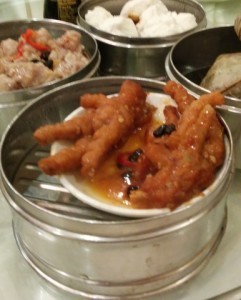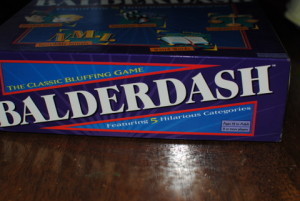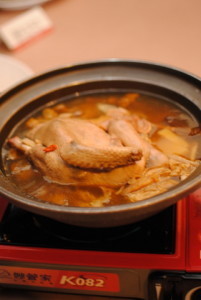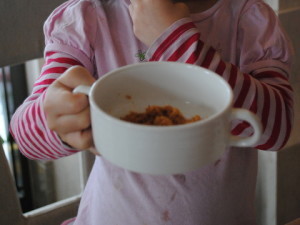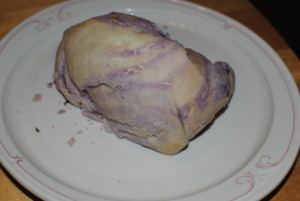Jennifer J. Chow's Blog, page 64
April 7, 2014
“Who’s Your Mama?” & Other Greetings
“Ivory does not come out of a dog’s mouth.” -Chinese proverb

Wooly mammoth statue. Parc de la Ciutadella in Barcelona, Spain.
Salutations! How do you greet someone? In the Taiwanese culture, you can say Li tsiah-pa bue?, which means, “Have you eaten yet?”
Are you cognizant of your first words to a stranger? Typical starters in conversations are “Where are you from?” or “What do you do?” I was listening to an NPR show the other day and learned some interesting facts about opening gambits. For example, there are underlying meanings that you might not be aware of regarding:
Where are you from?
For Native Americans, it can refer to your tribe.
In South Central Los Angeles, it’s associated with your gang.
Alaskans use this question because most people are visitors from out of the area.
Florida has a slight variation with, “Where are you from up north?” (assuming that people travel farther south down the state to chase good weather)
What do you do?
Because of the recent economic downturn, this can be dangerous ground.
There are unpaid but important caregivers (for kids, aging parents, etc.) who may be uncertain how to answer this.
This can be a subtle and unwelcome maneuver to ascertain income/status.
In different regions of the country, other questions arise, like:
What part of New York are you from? (New York)
What church do you go to? (South Carolina, rural Idaho, Virginia)
What high school did you go to? (St. Louis, Missouri; and across the country, esp. in small and rural communities)
What exit are you from? (New Jersey)
Who’s your mama? (New Orleans; to provide family background)
In Los Angeles, where I live, maybe we could ask:
Trojan or Bruin? (Big USC vs UCLA rivalry here.)
What kind of car do you drive? (It’s a fact that many residents have cars in this sprawling area.)
Fave celebrity? (We are near Hollywood after all.)
What greetings have you heard or want to hear?
April 4, 2014
Foodie Friday: Chicken Feet
Chicken feet: a dim sum delicacy
Waste not, want not. Chicken feet is a common dish on dim sum carts. Its distinctive claw-like pose helps you discern it even from a distance. I haven’t had them since early childhood, but the skin is supposed to be quite gelatinous. (Just be careful of all the small bones.) Some diners have an art of popping the foot in their mouth and extracting all the meat invisibly (kind of like tying a cherry stem with your tongue). If you’re brave enough to cook this dish, you can find the recipe here. My squeamishness at eating chicken feet comes not only from their unaesthetic display, but also because I owned several chickens before. RIP, beloved childhood pets!
March 31, 2014
Liar, Liar, Pants on Fire
“Genuine gold fears no fire.” -Chinese proverb
Are storytellers good liars? Maybe. A recent quiz in The New York Times called “Can You Spot the Liar?” features videos of people answering questions with truth or lies. The related article states that body language may be a poor reflection of veracity and that verbal clues are more accurate. Does that mean that writers, who can craft compelling stories, are better at lying?
My own track record reveals a mixed bag:
Balderdash- I’m excellent at this game. Whenever I don’t know the true meaning, I imitate the cadence of a dictionary definition. I’ve been able to really convince some players. Thumbs up.
Sneaking- I tried to sneak into a convention once with my brother’s ID. Maybe not the best of ideas, but he’d already paid for it and couldn’t make it that particular day. I wanted to check out the place and meet up with my boyfriend who was also attending the event. The guard at the door looked at the nametag and then my face. “Is that your name?” she asked. I didn’t want to lie, so I silently stood there with her staring at me for a full minute. After giving me the stink eye, she eventually let me pass through. Thumbs down.
Mafia - I’m not the last to get knocked out in this game and have a medium lifespan. I can never guess the true culprits, though. Neutral.
Although I’m not a great liar, I’m wonderful at being lied to. I have certain traits that make me more susceptible, such as being:
Gullible- As a child, I succumbed to the great marshmallow trick one April Fool’s Day. Even in college, my friend insisted that strawberries grew on trees. “Really?” I said, even though I’d actually seen strawberry plants in my parents’ garden before. I thought maybe somewhere out there existed a tree that sprouted strawberries….
Trusting- It’s hard for me to figure out when people close to me are fibbing. (This is also true about unreliable narrators in books.) I remember doing Two Truths and a Lie with my family and discovering that my dad had played rugby before. Who knew?
Empathetic- I’m a sucker for scams. A frantic woman approached me one day, saying that her husband had been injured in a work accident. She asked me for money but offered to give either her drivers’ license or cell phone as collateral and proof of her sincerity. I decided to help her out. Figuring she’d need her license to take her spouse to the hospital, I requested to keep her phone. I ended up holding a plastic toy while she sprinted away to her car. (I probably should have known better when I saw that her car had been parked in a weird position, making it difficult to read the license plate.)
Please share your experience with tall tales.
March 28, 2014
Foodie Friday: String Beans
String beans: long, slender strands of green beans, cooked with garlic and ginger
When I was a kid, I remember marveling at the long strands of green beans I spied in Chinese restaurants. Sometimes I saw workers sitting patiently and snapping the beans into small, edible sections. The long beans are stir-fried into a tasty dish with the addition of garlic and ginger; some recipes result in a spicier, Szechuan version.
It’s amazing that something so simple can be so delicious–I love the abundance of fresh crispy greens combined with the kick of garlic. I’ve even known finicky kids to enjoy this dish. Recently, I finally mastered the art of cooking American green beans and not making them too soggy (by steaming just a bit and then stir-frying them). Understanding the timing and skill needed for plain green beans, I’m in even more awe of the Chinese string bean dish.
What is one of your favorite vegetable dishes?
March 24, 2014
My Top 5 Soup Cures
“A good bee never takes pollen from a fallen flower.” -Chinese proverb
We need to fill our bodies with good things, nourishing foods. Sparked by my post on colds and congee, I’ve been thinking about nutritious soups I’ve encountered. Here are my top five soup cures:
1. Special Sesame Chicken Soup–provides energy for new mothers
In “The Rime of the Ancient Mariner,” it says, “Water, water everywhere. Nor any drop to drink.” This is the opposite of what happens with this chicken soup; it feels like a never-ending pot. The chicken soup is consumed for one month after a mother gives birth (twice a day). The ingredients of black sesame oil, ginger, and rice cooking wine are supposed to increase milk production, cleanse the womb, speed up the return to a pre-birth body shape, and provide needed energy.
There are two other soups that help a birth mother along (one with pig’s feet, and another with unripe green papaya), but I mostly drank this chicken dish. It’s actually pretty tasty–but make sure you boil off the alcohol or else it’s too strong! It does get a bit tiring to drink day after day (especially for other family members). Here’s the recipe, courtesy of my mother-in-law:
Ingredients:
1. one whole chicken; remove the fat of chicken. chopped into square size, 2×2
2. three pieces of ginger; each one is about the size of thumb, smashed flat
3. one - two bottles of rice wine (NO salt)
4. Sesame Seed oil, 4-5 tablespoonfuls
5. water, as needed
Cooking instructions:
1. Warm the cooking pot to medium heat.
2. After the pot is warm enough, pour the oil into the pot and continue on medium heat.
3. After oil is warm enough, add ginger and stir. Continue on medium heat.
4. After ginger is warm enough and slightly brown, then add chopped chicken. Stir well on medium heat.
5. After the chicken is slightly brown, add rice wine (medium heat).
6. Add water to cover over the chicken. Use medium-high heat.
7. After soup is boiled, reduce the heat to low.
8. Slow cook for one plus hours, until well done.
2. Beef Broth–heals muscles
This soup is made by slow-cooking beef for multiple hours and has an intense meat flavor. It’s supposed to aid in strengthening muscles. (It seems to be working well for my brother, who injured his leg!)
3. Ginseng juice–lowers cholesterol, reduces blood sugar
Place a chicken breast in a slow cooker, along with several pieces of ginseng. (Wisconsin ginseng is known for its high quality.) Boil on low for multiple hours. This broth tastes very herbal and medicinal (aka bitter).
4. Abalone soup–prevent arthritis, improve circulation
Abalone is a mollusk and tastes similar to scallop. It provides a nice seafood flavor to the soup. However, since it’s valued in Asian dishes, abalone is priced pretty high in the stores.
5. Winter melon soup–relieves stomach ailments
This is one of my favorite soups because the melon absolutely disintegrates in your mouth. It’s a clear broth that offers a slight sweetness to it.
March 21, 2014
Foodie Friday: Congee
Congee: rice porridge
I’m feeling a bit under the weather today… which leads me to today’s post about congee. It’s a great meal when you’re sick. The porridge turns out hot and soothing to your throat. Also, it’s an easy dish to make: Boil rice over a long period of time (I hear some rice cookers have a special “congee” setting), adding in broth for further flavor. The jook (Cantonese) or muay (Taiwanese) can be topped off by bright green scallions, youtiao (fried bread sticks), or meaty pork sung (see photo above).
March 17, 2014
Of Wasps and Chinese Lanterns
“A swarm of mosquitoes can sound like thunder.” -Chinese proverb
My story’s not about mosquitoes. It involves a different pesky insect. With spring coming, birds are chirping and flowers are bursting into color. But there may also be the arrival of paper wasps in our area. Similar to yellow jackets in looks, the paper wasp is a bit longer and more slender. Yellow jackets love meat and are pretty aggressive, while paper wasps are docile.
Nevertheless, their striped danger markings scare me. (This is probably because I was stung by a bee as a child and ended up missing the Charlotte’s Web movie at school. So sad.) Yellow jackets prefer underground homes, while paper wasps’ hives are exposed, comb-like structures.
One year, I found these insects trying to enter our house. Why? Chinese lanterns. I had hung some up as festive decorations, but the wasps mistook them for their natural homes.
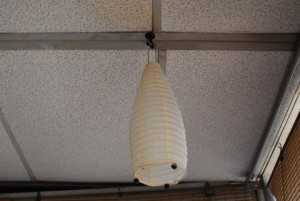
Lantern
Yikes!
Have you had any funny incidents with bugs, pests, or other creatures? Please share!
March 14, 2014
Foodie Friday: Green Tea Cake
Green tea cake: the beverage turned into a delicious cake
Here’s my tried and true way of celebrating: Cake! (Want a reason to party? How about my book as a finalist for Book of the Year Award?)
Not just any type of cake will satisfy my cravings. My go-to is green tea cake. It’s not too sweet, and I can indulge while convincing myself I’m stocking up on antioxidants. A swirl of whipped cream adds a hint of sweetness to this traditional roll cake, while the red beans provide a contrasting, chewy texture.
My cake preferences have changed throughout the years, morphing from “pink champagne” and “cookies and cream” to green tea, mango, and taro.
What was or is your favorite cake flavor?
March 10, 2014
Literature that Crosses Cultural Boundaries
“Observers can see a chess game more clearly than the players.” -Chinese proverb
A writer friend posed this question to me the other day: Is it okay to write material beyond your own culture? I think so. The point of fiction is to explore and imagine. We need to be able to capture new perspectives and lives unfamiliar to our own.
Maybe observers can see the “chess game” more clearly; perhaps outsiders will depict different cultures well. Besides, we wouldn’t have the neat novel that is The Art of Racing in the Rain by Garth Stein, if we scoffed at a book told from a dog’s point-of-view.
And isn’t there a double standard to that question? Caucasian writers tell tales about different cultures all the time:
Memoirs of a Geisha by Arthur Golden (the perspective of a geisha working in Kyoto)
Little Bee by Chris Cleave (many passages “spoken” by a 16 year-old Nigerian)
Under Fishbone Clouds by Sam Meekings (observations on a Chinese couple through Mao’s Cultural Revolution and beyond)
Ethnic authors also head beyond comfortable territory, but they’re few and far between. A classic example I can think of is Kazuo Ishiguro who’s born in Japan but wrote the wonderful book, The Remains of the Day, which explores the British butler system. (Ishiguro was raised in Britain, though.)
A more recent author, Bill Cheng, has written Southern Cross the Dog, detailing three childhood friends and featuring the Great Mississippi Flood of 1927. (Cheng is Chinese-American and never visited Mississippi before writing the novel.) I haven’t read it yet, but I heard it vibrates with a dark Southern Gothic tone.
What do you think about crossing cultural boundaries? Have you read any interesting books that would fit in this category?
March 7, 2014
Foodie Friday: Taro Swirl Bread
Taro swirl bread: soft bread with sweet taro inside
I like my taro. Once when I visited Hawaii, I remember spending a long time entranced in a field, gazing at the broad leaves of the taro plant. For my wedding, we had ube cake. At dim sum, I eat fried taro dumplings. I’ve never ventured beyond either the purely sweet versions (cake) or the salty dishes (dumpling). Now, introducing: the taro swirl bread.
This bread contains both a sweet filling and a salty, soft exterior. The patterns that run across this bread are gorgeous. Despite the aesthetics, though, I really wish that this taro dish picked one taste or the other. When I bit into the outside, I expected a meat-bun-like quality. Then I encountered the inside, which set me up for a sweet dessert. I couldn’t balance the two tastes. In the end, it’s a thumbs-up for the artistic image, but a thumbs-down for the flavor combo.

